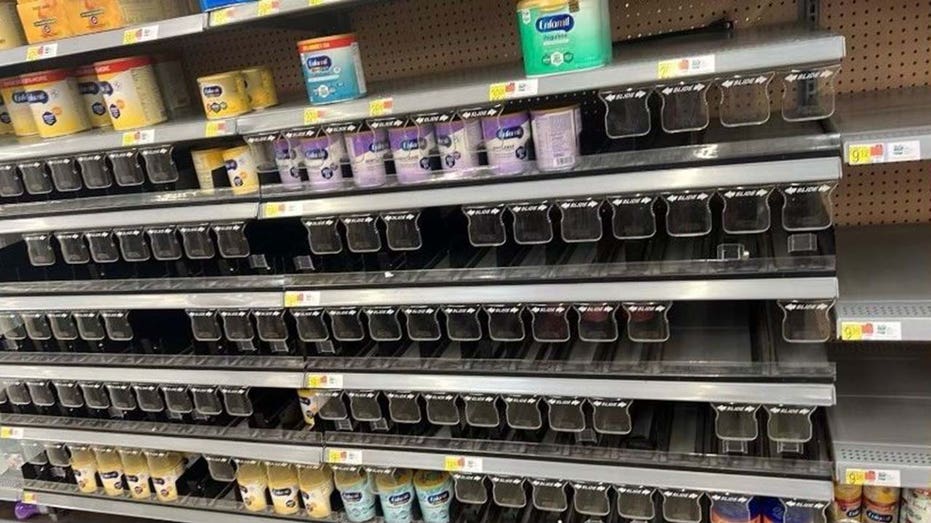Baby formula by the numbers: Facts about the multibillion dollar industry
Baby formula shortage hits American families: Here’s what you should know about the milk substitute market
Baby formula shortage a ‘big problem’: Dr. Siegel
Baby formula shortage a ‘big problem’: Dr. Siegel Fox News contributor Dr. Marc Siegel argues that the U.S. needs to ‘ramp up’ federal involvement to resolve the baby formula shortage.
The baby formula shortage has become an ongoing crisis as parents continue hunting for products nationwide.
The U.S. Food and Drug Administration announced it will take "important steps" to remedy the country's formula supply chain after American parents and pediatricians made their concerns known about the current formula shortage.
"We recognize that many consumers have been unable to access infant formula and critical medical foods they are accustomed to using and are frustrated by their inability to do so," said FDA Commissioner Robert M. Califf, on Tuesday, May 10. "We are doing everything in our power to ensure there is adequate product available where and when they need it."
BABY FORMULA SHORTAGE: WHICH FOODS AND TECHNIQUES BOOST BREAST MILK PRODUCTION?
The worrisome shortage stems in part from a formula recall and pandemic-related production strains.
Here's a by-the-numbers breakdown on the milk substitute market.
1 – Parents can stop feeding baby formula to infants after they’ve reached the one-year mark, according to the Centers for Disease Control and Prevention's (CDC) nutrition guidelines.
6 – There are six major baby formula manufacturers that are registered with the FDA. The brands include Abbott Nutrition, Mead Johnson Nutritionals (Bristol-Myers Squibb Company), Nestle Infant Nutrition, PBM Nutritionals, Prolacta Biosciences, Inc., and Nutricia North America (SHS International Limited).
CAN YOU USE EXPIRED BABY FORMULA?
8 to 12 – Baby formula reliant newborns should be fed one to two ounces of formula "8 to 12 times in 24 hours" in the first days of life, the CDC’s nutrition guidelines state. As babies get older, they can be fed formula "about every 3 to 4 hours" until the five-month mark. From six to 12 months, formula feedings can decrease to "about 5 to 6 times in 24 hours," the CDC says.

Baby formula is a breast milk replacement for infants. The industry became commercialized more than 150 years ago. (Paulo Sousa / EyeEm)
12 – The current birth rate in the U.S. is 12.012 births per 1,000 people, according to projections from the United Nations. If that estimate is correct, that’s a 9.2% increase from the birth rate the CDC reported in 2020, which was 11.0 per 1,000 people (approximately 3.6 million births).
19 – Baby formula was invented in the 19th century. Nutrition scientists noted a rise in infant mortality after "dry nursing" – feeding animal milk to babies – grew in popularity, according to Contemporary Pediatrics, an Ohio-based journal that publishes peer-reviewed articles and clinical studies.
In 1838, German physician Johann Franz Simon analyzed human and cow milk, and he found that the latter had a "higher protein content and a lower carbohydrate content." From that chemical breakdown German chemist Justus von Liebig developed the world’s first commercial baby formula – Liebig's Soluble Infant Food – in 1967, which was made from wheat flour, cow's milk, malt flour and potassium bicarbonate.
AMERICA'S BABY FORMULA SHORTAGE: PHOTOS SHOW THE STARTLING REALITY
20% – Nearly 20% – or one in five (19.2%) – newborns were given baby formula within the first two days of life, the CDC’s 2020 Breastfeeding Report Card found.

Empty store shelves in Columbus, Ohio, as parents panic over worsening baby formula shortage. (FOX Business)
29 – The FDA requires baby formula manufacturers to meet certain nutrient specifications in order to be sold in the U.S. The required specs include "minimum amounts for 29 nutrients," according to a consumer Q&A published by the FDA. Nine of those nutrients have "maximum amounts" assigned to them.
$1,200 to $1,500 – Families that depend on baby formula spend $1,200 to $1,500 per year on the breast milk substitute on average, according to current estimates published by the U.S. Surgeon General.
GET FOX BUSINESS ON THE GO BY CLICKING HERE
$5.81 billion – The infant formula market is expected to reach $5.81 billion in America by the year 2027, according to Allied Market Research (AMR), a global market research firm based in Portland, Oregon. AMR released its report, "U.S. Baby Infant Formula Market" in 2021, citing that the increase of women in the workforce and "high nutritional content" of formula as the factors driving market growth.
$50.46 billion – In 2019, the global baby formula market size was valued at $50.46 billion, according to a market research report published by Fortune Business Insights – a global market study and consulting company based in Pune, India.

The CDC says babies can be fed formula until they reach the one-year mark. (iStock)
$109.1 billion – Fortune Business Insights' most recent baby formula market report has forecasted that the baby formula market’s value could grow up to $109.1 billion by 2027. If that estimate turns out to be correct, that would be a compound annual growth rate of 10.6% in an eight-year period.
CLICK HERE TO READ MORE ON FOX BUSINESS




















